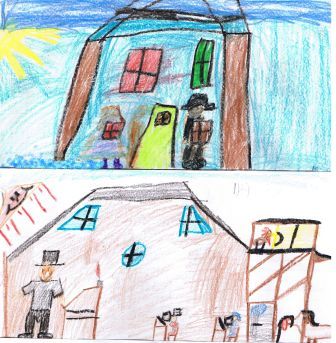
Human transformation of vast areas of Earth over time has necessitated protection of wildlife habitats. In 1903 President Theodore Roosevelt established
 the first national refuge on Pelican Island in Florida. The National Wildlife Refuge System has since grown to include more than 540 refuges in all 50 states and many U.S. territories, encompassing more than 94 million acres.
the first national refuge on Pelican Island in Florida. The National Wildlife Refuge System has since grown to include more than 540 refuges in all 50 states and many U.S. territories, encompassing more than 94 million acres. 
Next came the most exciting part of the program: show and tell. Exotic wildlife artifacts were displayed and carried around the auditorium by parent volunteers. Students touched the skull of a loggerhead sea turtle, felt turkey feathers, hooted at animal "scat," and discovered that the skin of a horseshoe crab is shed much as a snake sheds its skin.
Janis explained that as a biologist, her job basically is to learn about and protect wildlife. But the
 National Wildlife Refuge System has various jobs available, including special agents and wildlife detectives to help fight poaching and the illegal use of animal parts in clothing, jewelry, and otherwise. Special agents are stationed at airports to catch people trying to smuggle illegal animals into the United States, such as turtles — for barrettes — and baby alligators — for handbags.
National Wildlife Refuge System has various jobs available, including special agents and wildlife detectives to help fight poaching and the illegal use of animal parts in clothing, jewelry, and otherwise. Special agents are stationed at airports to catch people trying to smuggle illegal animals into the United States, such as turtles — for barrettes — and baby alligators — for handbags.She told students that it was her own experience witnessing the illegal use of animals that inspired her to become a wildlife biologist. She encouraged students to do their part to protect wildlife and educate others about the importance of that protection. The program concluded with students writing and
 drawing in their journals about one special thing they had learned that afternoon.
drawing in their journals about one special thing they had learned that afternoon.- “I learned we need to take better care of our community and natural habitats. I also learned how many animals are endangered…”
“Never kill for fun! Don’t hunt to get fancy stuff!”
- “People would kill an elephant [to use its] foot for a wastebasket or take an antelope and make a coat. They would turn a sea turtle upside down so it can suffer. They would use a sea turtle’s shell for a barrette. Some people would kill a rhinoceros [to use its] horn to make jewelry. People would hunt animals for something on their body to get money. How would you like it if someone killed you? I liked this program.”
- “I learned that every creature is equal and you shouldn’t [poach]
them just for one part of them.”
- “I learned that you can’t just kill an animal for no reason and that that’s why they have wildlife refuges.”
- “I will never kill animals. They're almost my favorite thing in the world.”
- “I learned that we should not use animals' skin and things on animals. Because if we do, more and more animals are
 killed each day. Then those animals are going to be extinct.”
killed each day. Then those animals are going to be extinct.” - “Today I learned that some people use elephant feet for trashcans and use antelope feet for ashtrays. I also learned that piping plovers are the most endangered animal in Rhode Island. Some people use peices of turtle backs for barrettes.”
- “I learned that it is not good at all to harm an animal just for an item on the animal.”
 an antelope and make a coat. They would turn a sea turtle upside down so it can suffer. They would use a sea turtle’s shell for a
an antelope and make a coat. They would turn a sea turtle upside down so it can suffer. They would use a sea turtle’s shell for a  barrette. Some people would kill a rhinoceros horn to make jewelry. People would hunt animals for something on their body to get money. How would you like it if someone killed you? I liked this program.”
barrette. Some people would kill a rhinoceros horn to make jewelry. People would hunt animals for something on their body to get money. How would you like it if someone killed you? I liked this program.”Article by Jon Pincince & Rian Smith






No comments:
Post a Comment